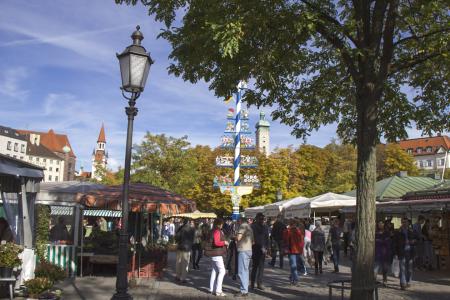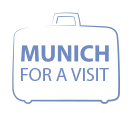Historical Munich
Munich was founded 1158 when salt was one of the most important trading goods. The salt was shipped from Salzkammergut in Austria to the West and the truck had to cross the river Isar near Munich close to a place that is called Oberföhring. The bridge in Oberföhring belonged at that time to the bishop of Freising who had a good earning from the toll.
A legend tells that Henry the Lion, Duke of Saxony and Bavaria, burned down the bridge to rebuild it further south, close to a Monk’s settling on his own territory. In 1158 this settling was called „Munichen“ and received the market right by the Emperor Friedrich Barbarossa.
The beginnings
Long before Munich was founded monks were settling on a little hill which is today right in the city center, the “Petersbergl“. This is where the name was derived from “ad munichen“, which later became “München”.
The Bavarian Duke Henry was Guelph. That’s why there is a lion in the Bavarian arms. The monks can be found in the Munich arms with a black cowl on a yellow setting. Today this called the Munich child, “Münchner Kindl”.
After Duke Henry had to escape to England, the duchy of Bavaria the Wittelsbach dynasty became Duke of Bavaria and Munich was handed over to the bishop of Freising. In 1240 Munich was transfered to Otto II Wittelsbach and in 1255 Munich became the ducal residence.
The rise of Munich
Munich’s position was strengthened very early from 1314 to 1347 when the German king Louis resided in Munich.
In 1369 more than 10,000 people lived within the city of Munich. From 1500 onwards (late-gothic, renaissance, baroque era) Munich underwent an increase in prosperity. At the beginning of the 16th century Munich became electoral residence when Maximilian I, Duke of Bavaria was invested with the electoral dignity.
The turn
The actual creator of the so called new Munich is King Ludwig I (1825-1848) who brought forward artistic and cultural activity in the city and made Munich a centre of the intellectual elite.
But the turn from the 18th to the 19th century was followed by wars and occupations, too, which made the people suffer. At the beginning of the 19th century Munich was occupied by the French for nearly a year and from 1805 they suffered under occupancy by the Austrians.
Munich during the Nazi era
After World War I Munich experienced a massive recession. Poverty, housing shortage and unemployment were an excellent breeding ground for the ideology of the National Socialists. From 1933 until the end of the so called „Third Reich (Third Empire)“ , Munich became a Nazi stronghold. But Munich was also a center of the resistance. One of the well known resistance groups was „Weiße Rose“ (white rose) which was a student initiative. In 1942 the group distributed a flyer against the Nazi regime and its inhumanity and encouraged people to show passive resistance. The members of “Weiße Rose” were executed in 1943. Today there are Tours and Guides to learn more about the Nazis, Hitler and the Third Reich.
From 1945 until today
During the World War II about 45% of all buildings in Munich were damaged or destroyed. Munich was completely rebuilt following a precise and rather conservative plan which preserved its pre-war street grid and the historical setting of the city. Thanks to the so called “Wirtschaftswunder” (economic miracle) in the 50s and 60s Munich’s population passed the 1 million mark.
Other important events in Munich were the Summer Olympics in 1972, the football World Cup in 1974, the construction of the new Munich Airport "Franz-Josef-Strauss“ and the football World Cup in 2006. Munich has an enormous economic potential which is backed up by the continuing building boom. Today more than 1.4 million people live within the city of Munich.



